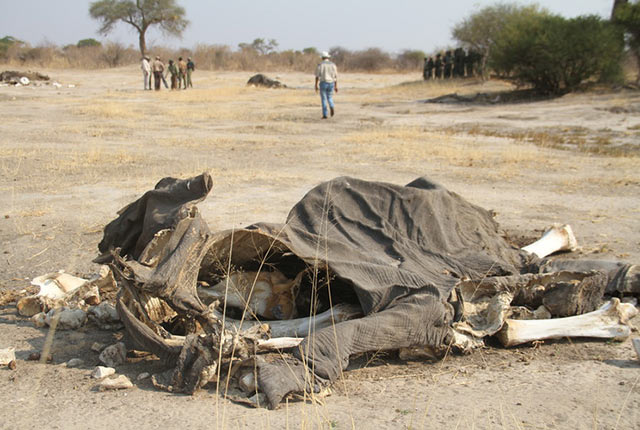Protecting elephants is everyone’s duty

Jeffrey Gogo Climate Story
ANIMAL lovers around the world on August 12 celebrated the World Elephant Day, as the world’s largest land mammal faces increasing threats from habitat loss, climate change, and more importantly, poaching.
Recognised by the UN, the World Elephant Day seeks to bring attention and action to these threats and more, as the number of elephants in Africa continue to decline, falling from 1,3 million in 1970 to just 475 000 in 2014, according to the African Wildlife Foundation.
Illegal killings of the African elephant remain the greatest threat. Scientists estimate over 30 000 elephants are killed each year for their ivory.
Each tusk fetches as much as $15 000 on the street, and several times as much in China.
In countries like Zimbabwe, the elephant has a lot of economic value.
Trophy hunting rakes in millions of dollars in earnings each year while the animal is a huge drawcard in the billion-dollar-tourism industry.
But the elephant is also a major worry here. At 80 000, according to official estimates, the herd is twice as big the actual number of animals Zimbabwe’s reserves and conservancies can accommodate.
This has fanned deadly conflicts with humans, as ecosystems come under pressure from the over-population.
Wildlife conservationists the world over are at pains trying to protect this species, listed by the International Union for Conservation and Nature as “endangered.”
The World Elephant Day represents one of several strategies to raise awareness on the strategic importance of elephants not only in those African economies reliant, in part, on wildlife tourism, but the entire world.
CITES, the global watchdog for endangered animal species, has gone as far as banning all trade in ivory, as part of measures to combat poaching – measures currently facing fierce resistance from Zimbabwe, which is holding 96 tonnes in unsold ivory, and from much of SADC.
Revenue from commercial ivory sales can help boost conservation work, they argue.
The US, one of Zimbabwe’s biggest tourism source markets, has announced a near complete ban in ivory while China, the greatest consumer of ivory, is headed the same route.
It is a real tug of war between those countries burdened with controlling excessive populations of this great beast, and those in the West, rich but without the daily experience of living with the animal.
Zimbabwe’s last commercial ivory sale occurred nearly a decade ago.
A once-off sale of 3 700kg to Japan and China on November 1, 2008, generated about $500 000, which was duly declared to the Convention of International Trade in Endangered Species (CITES), ZimParks acting director general Mr Wilson Mutinhima told The Herald Business, by telephone, recently.
Now, to mark the World Elephant Day, I spoke with Matthew Brown, Africa region conservation director at US conservation organisation, The Nature Conservancy, picking his thoughts on ivory trade and other related conservation issues.
The Nature Conservancy has a presence in several African countries monitoring elephant populations, helping governments to provide better protection and habitat management in key elephant ecosystems.
Below is an excerpt of the interview. I am represented JG and Matthew Brown, MB.
JG: Zimbabwe has been pushing that international rules on ivory trade are relaxed to allow for countries with huge stockpile of ivory like itself earn something, which money would be channelled into wildlife conservation. Do you believe complete bans in ivory trade will tame poaching effectively? And what should countries like Zimbabwe do with their excessive ivory inventory?
MB: Bans in ivory trade will help all countries on both the supply and demand side of the problem to put better systems in place. Today there is no way that a legal trade of ivory could work because the immigration ports and resellers and the wildlife departments do not have the ability to discern illegal from ‘legal’ ivory. A ban is needed to control the poaching and yes the hope is that this action will reduce the illegal trade.
For now our perspective is that 1) we support landscape conservation — the loss of habitat is the big issue for elephants on the continent and 2) we need to reduce demand and 3) we support making all sales illegal at this time and see President Xi (Jin Ping) and (Barack) Obama’s recent statements as extremely encouraging.
JG: Zimbabwe has one of the toughest wildlife crime laws in Africa. The country has a shoot-to-kill policy for poachers. Those arrested for poaching face a mandatory minimum nine years in jail. But this has done little to end or minimise poaching. What are the real issues driving poaching in Africa, really? With so much poverty across the continent, can poaching be tamed, how?
MB: While increasing penalties and having tough wildlife crime laws helps significantly, there is no ‘single’ answers. We need to reduce the demand for ivory. We also need to increase the value that local people see in elephants via eco-tourism benefits, jobs, support for education, health care etc from elephants. We need for local people to see elephants worth more alive than dead.
JG: For traditional reasons, many communities in Zimbabwe do not regard hunting a crime. They actually see it as a right. How can governments balance the need to preserve such traditional practices where there is no criminal intent, with those sentences meted out on hardcore wildlife criminals?
MB: I think this is a tough issue. If elephants are being killed in retaliation for raiding crops, then governments could look at investing in some strategic fencing or some crop protection measures like radio frequency collars on problematic elephants, for example. But ideally there is a clear message that killing of elephants is a crime and that with the current crisis it is not acceptable to kill, even for cultural reasons.
JG: How can communities living in wildlife areas benefit more from the proceeds of the different tourism activities happening within their areas?
MB: Jobs is the highest ranked benefit. But funding for schools, clinics and increased security that goes with tourism are also benefits. Typically, communities who are self-organised (village or conservancy) and present a clear need and the ability to work in partnership with tourism lodges will receive greater benefit and be able to have their needs shared with the daily flow of foreign tourists in their area. So proactive engagement, transparent community leadership and presentation of a clear plan are all some examples of how communities can be perhaps see better gain from tourism.
God is faithful.








Comments